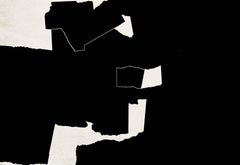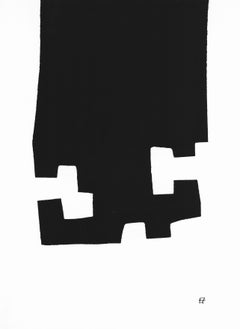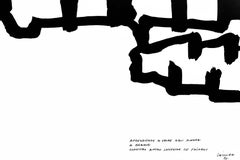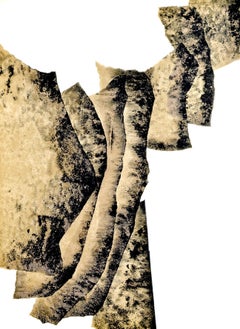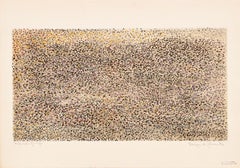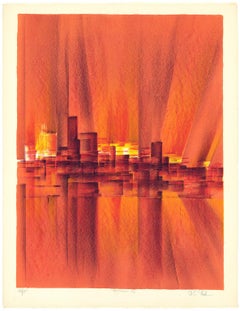Eduardo Chillida Landscape Prints
Spanish, 1924-2002
Eduardo Chillida studied in Madrid and then went to Paris, where he was influenced by Pablo Palazuelo in his first figurative work, done in plaster and clay. Other influences were Frank Lloyd Wright, Albert Giacometti and Joan Miro. In 1950, he began doing printmaking lithography, woodcuts, etchings, drypoints and silkscreens. His graphics are not related to his sculpture but are creative expressions unto themselves. During the 60s, his graphics tended to be massive black lines on white, giving the appearance of realistic shapes.
to
4
2
2
Overall Width
to
Overall Height
to
4
41
180
169
146
131
4
3
1
2
2
4
4
Artist: Eduardo Chillida
(tariff free*) Sans titre, Derrière le miroir
By Eduardo Chillida
Located in Southampton, NY
Lithograph on vélin paper. Inscription: Unsigned and unnumbered, as issued. Paper Size: 15 x 22 inches, with centerfold, as issued. Notes: From Derrière le miroir, N° 124, 1961. Publ...
Category
1960s Modern Eduardo Chillida Landscape Prints
Materials
Lithograph
$716 Sale Price
20% Off
Eduardo Chillida, Untitled, from Derriere le Miroir, 1982
By Eduardo Chillida
Located in Southampton, NY
This exquisite lithograph by Eduardo Chillida (1924–2002), titled Sans titre (Untitled), originates from the historic 1982 folio Derriere le Miroir, No. 250, Hommage a Aime et Marguerite Maeght (Tribute to Aime and Marguerite Maeght). Published by Maeght Editeur, Paris, under the direction of Aime Maeght, and printed by Imprimerie Moderne du Lion, Paris, this composition embodies Chillida’s exploration of form, balance, and spatial tension. In Sans titre, the artist distills his sculptural sensibility into a two-dimensional plane, using the language of gesture and contrast to evoke mass, gravity, and void. The work exemplifies Chillida’s poetic approach to abstraction, where line and density coexist in perfect equilibrium.
Executed on velin paper, this lithograph measures 15 x 11 inches (38.1 x 27.9 cm). As issued, it is signed in the plate and unnumbered, consistent with the authorized publication format. The edition captures Chillida’s mastery of minimal means to achieve monumental expression, extending the spatial dialogue that defines his sculpture into the medium of print.
Artwork Details:
Artist: Eduardo Chillida (1924–2002)
Title: Sans titre (Untitled), from Derriere le Miroir, No. 250, Hommage a Aime et Marguerite Maeght (Tribute to Aime and Marguerite Maeght), 1982
Medium: Lithograph on velin paper
Dimensions: 15 x 11 inches (38.1 x 27.9 cm)
Inscription: Signed in the plate and unnumbered, as issued
Date: 1982
Publisher: Maeght Editeur, Paris
Printer: Imprimerie Moderne du Lion, Paris
Condition: Well preserved, consistent with age and medium
Provenance: From the 1982 folio Derriere le Miroir, No. 250, published by Maeght Editeur, Paris
Notes:
Excerpted from the folio (translated from French), This special issue of Derriere le Miroir was designed and defined by Aime Maeght in the fall of 1980. He envisioned its publication as a celebration with which artists and writers published since 1946 were to be associated. He also chose Francois Chapon, president of the Reverdy Committee, to write the presentation. This Derriere le Miroir number 250 took the form, after its disappearance on September 5, 1981, of a tribute to Aime Maeght and his wife Marguerite Maeght who died four years earlier. 24 artists agreed to create an original graphic work for this issue which includes the general table of all issues as well as excerpts from texts by 32 writers. Finished printing on June 2, 1982 on the presses of the l'Imprimerie moderne du Lion in Paris. CL examples were printed on velin d'Arches, numbered from I to CL, and some non-commercial examples constituting the original edition.
About the Publication:
Derriere le Miroir (translated as "Behind the Mirror") was an iconic French art periodical published from 1946 to 1982 by Maeght Editeur, one of the most influential art publishers of the 20th century. Founded by Aime Maeght in Paris, the publication was conceived as a visual and literary collaboration between leading modern artists, poets, and critics. Each issue functioned as both an exhibition catalogue and a work of art in itself—featuring original lithographs printed directly from the artists' stones or plates, alongside essays, poems, and critical commentary. Over the course of 36 years, Derriere le Miroir produced more than 250 issues and showcased an extraordinary roster of artists including Henri Matisse, Marc Chagall, Joan Miro, Georges Braque, Alexander Calder, Fernand Leger, Pierre Bonnard, Alberto Giacometti, Eduardo Chillida, Ellsworth Kelly, Francis Bacon, Paul Rebeyrolle, Claude Garache, Antoni Tapies, Bram van Velde, Pierre Alechinsky, Pol Bury, Shusaku Arakawa, and Gerard Titus-Carmel. Printed in the ateliers of Mourlot, Arte, and Imprimerie Moderne du Lion, the periodical set new standards for quality in color lithography, combining fine art printing with elegant typography and poetic text. Beyond its visual brilliance, Derriere le Miroir also became a cultural chronicle of postwar European modernism. Each issue coincided with exhibitions held at Galerie Maeght, providing a collectible and widely accessible record of groundbreaking shows. Its integration of image, text, and philosophy created a dialogue between art and literature that elevated the modern art book to new aesthetic heights. Today, Derriere le Miroir remains one of the most sought-after and historically significant art publications, prized by collectors and scholars alike for its craftsmanship, influence, and its role in defining the visual language of 20th-century modernism. The Maeght Foundation in Saint-Paul-de-Vence continues to honor this legacy through exhibitions and archival preservation of the series, affirming Derriere le Miroir's enduring place in the history of modern art and fine art publishing.
About the Artist:
Eduardo Chillida (1924–2002) was a Spanish Basque sculptor and printmaker internationally celebrated for his monumental abstract works that explore the interplay between form, space, and material. Renowned for his mastery of iron, steel, stone, and concrete, Chillida created sculptural compositions that evoke both architectural strength and poetic balance, reflecting his lifelong dialogue between the physical and the spiritual. Emerging in postwar Europe, his art stands alongside that of the great modern masters—Pablo Picasso, Henri Matisse, Alexander Calder, Marc Chagall, Salvador Dali, Joan Miro, Georges Braque, Wassily Kandinsky, Marcel Duchamp, and Man Ray—whose revolutionary approaches to form and perception shaped 20th-century art. Chillida’s work embodies a profound sense of harmony, rooted in the landscapes and philosophies of his native Basque Country, while maintaining a universal resonance. Exhibited internationally and collected by major institutions including MoMA, the Guggenheim, the Tate, and the Centre Pompidou, his sculptures and works on paper continue to command global acclaim. The highest price ever paid for an Eduardo Chillida artwork is approximately $4.1 million USD, achieved in 2022 at Christie’s Paris for Buscando la Luz IV (2001).
Eduardo Chillida Sans titre, Eduardo Chillida lithograph, Chillida Derriere le Miroir, Chillida Maeght...
Category
1980s Modern Eduardo Chillida Landscape Prints
Materials
Lithograph
$716 Sale Price
20% Off
Eduardo Chillida, Homage to Georges Braque, from Derriere le Miroir, 1964
By Eduardo Chillida
Located in Southampton, NY
This exquisite lithograph by Eduardo Chillida (1924–2002), titled Sans titre (Untitled), originates from the 1964 folio Derriere le Miroir, Nos. 144–145–146, L’Hommage a Georges Braque (Tribute to Georges Braque). Published by Maeght Editeur, Paris, under the direction of Aime Maeght, and printed by Mourlot Freres, Paris, this composition exemplifies Chillida’s mastery of spatial balance and sculptural abstraction. In Sans titre, Chillida translates his distinctive exploration of mass and void into two dimensions, creating an interplay of dense form and open space that mirrors the structural poetry of his sculpture and a heartfelt tribute to Braque, “Learning to fly down here — to Braque, master, friend, inventor of birds.” The composition conveys a sense of weight and stillness, embodying the meditative precision for which Chillida is renowned.
Executed on velin paper, this lithograph measures 15 x 22 inches (38.1 x 55.9 cm), with centerfold, as issued. Signed in the plate and unnumbered, as issued. The edition captures Chillida’s unique sensitivity to form and rhythm within a printed medium, reflecting the same architectural strength that defines his sculptural practice.
Artwork Details:
Artist: Eduardo Chillida (1924–2002)
Title: Sans titre (Untitled), from Derriere le Miroir, Nos. 144–145–146, L’Hommage a Georges Braque (Tribute to Georges Braque), 1964
Medium: Lithograph on velin paper
Dimensions: 15 x 22 inches (38.1 x 55.9 cm), with centerfold, as issued
Inscription: Signed in the plate and unnumbered, as issued
Date: 1964
Publisher: Maeght Editeur, Paris
Printer: Mourlot Freres, Paris
Condition: Well preserved, consistent with age and medium
Provenance: From the 1964 folio Derriere le Miroir, Nos. 144–145–146, published by Maeght Editeur, Paris
Notes:
Excerpted from the folio (translated from French): Taken from this special issue of “Behind the Mirror,” CCCL examples on velin de Rives were numbered, constituting the original edition of L’Hommage a Georges Braque. These deluxe examples also included an etching based on Trois oiseaux sur fond violet. The lithographs for this issue were printed in the ateliers of Maeght Editeur, Levallois. The text was printed by Fequet et Baudier, typographers. Finished printing May 13, 1964.
About the Publication:
Derriere le Miroir (translated as "Behind the Mirror") was an iconic French art periodical published from 1946 to 1982 by Maeght Editeur, one of the most influential art publishers of the 20th century. Founded by Aime Maeght in Paris, the publication was conceived as a visual and literary collaboration between leading modern artists, poets, and critics. Each issue functioned as both an exhibition catalogue and a work of art in itself—featuring original lithographs printed directly from the artists' stones or plates, alongside essays, poems, and critical commentary. Over the course of 36 years, Derriere le Miroir produced more than 250 issues and showcased an extraordinary roster of artists including Henri Matisse, Marc Chagall, Joan Miro, Georges Braque, Alexander Calder, Fernand Leger, Pierre Bonnard, Alberto Giacometti, Eduardo Chillida, Ellsworth Kelly, Francis Bacon, Paul Rebeyrolle, Claude Garache, Antoni Tapies, Bram van Velde, Pierre Alechinsky, Pol Bury, Shusaku Arakawa, and Gerard Titus-Carmel. Printed in the ateliers of Mourlot, Arte, and Imprimerie Moderne du Lion, the periodical set new standards for quality in color lithography, combining fine art printing with elegant typography and poetic text. Beyond its visual brilliance, Derriere le Miroir also became a cultural chronicle of postwar European modernism. Each issue coincided with exhibitions held at Galerie Maeght, providing a collectible and widely accessible record of groundbreaking shows. Its integration of image, text, and philosophy created a dialogue between art and literature that elevated the modern art book to new aesthetic heights. Today, Derriere le Miroir remains one of the most sought-after and historically significant art publications, prized by collectors and scholars alike for its craftsmanship, influence, and its role in defining the visual language of 20th-century modernism. The Maeght Foundation in Saint-Paul-de-Vence continues to honor this legacy through exhibitions and archival preservation of the series, affirming Derriere le Miroir's enduring place in the history of modern art and fine art publishing.
About the Artist:
Eduardo Chillida (1924–2002) was a Spanish Basque sculptor and printmaker internationally celebrated for his monumental abstract works that explore the interplay between form, space, and material. Renowned for his mastery of iron, steel, stone, and concrete, Chillida created sculptural compositions that evoke both architectural strength and poetic balance, reflecting his lifelong dialogue between the physical and the spiritual. Emerging in postwar Europe, his art stands alongside that of the great modern masters—Pablo Picasso, Henri Matisse, Alexander Calder, Marc Chagall, Salvador Dali, Joan Miro, Georges Braque, Wassily Kandinsky, Marcel Duchamp, and Man Ray—whose revolutionary approaches to form and perception shaped 20th-century art. Chillida’s work embodies a profound sense of harmony, rooted in the landscapes and philosophies of his native Basque Country, while maintaining a universal resonance. Exhibited internationally and collected by major institutions including MoMA, the Guggenheim, the Tate, and the Centre Pompidou, his sculptures and works on paper continue to command global acclaim. The highest price ever paid for an Eduardo Chillida artwork is approximately $4.1 million USD, achieved in 2022 at Christie’s Paris for Buscando la Luz IV (2001).
Eduardo Chillida Sans titre, Chillida Derriere le Miroir, Chillida Maeght...
Category
1960s Modern Eduardo Chillida Landscape Prints
Materials
Lithograph
Eduardo Chillida, Correlation, from Derriere le Miroir, 1960
By Eduardo Chillida
Located in Southampton, NY
This exquisite lithograph by Eduardo Chillida (1924–2002), titled Correlation, originates from the 1960 folio Derriere le Miroir, No. 119, Poetes, peintres, sculpteurs (Poets, Painters, Sculptors), published by Maeght Editeur, Paris, under the direction of Aime Maeght, and printed by Mourlot Freres, Paris. Correlation exemplifies Chillida’s masterful exploration of form, space, and equilibrium, transforming abstract geometry into a meditative dialogue between line and void. The work reflects the artist’s enduring search for spiritual and structural balance within the material world.
Executed on velin paper, this lithograph measures 15 x 11 inches (38.1 x 27.9 cm). Unsigned and unnumbered, as issued. The edition reflects the exceptional quality and craftsmanship of the Maeght and Mourlot collaborations, embodying Chillida’s refined aesthetic of sculptural abstraction translated into graphic form.
Artwork Details:
Artist: Eduardo Chillida (1924–2002)
Title: Correlation, from Derriere le Miroir, No. 119, Poetes, peintres, sculpteurs (Poets, Painters, Sculptors), 1960
Medium: Lithograph on velin paper
Dimensions: 15 x 11 inches (38.1 x 27.9 cm)
Inscription: Unsigned and unnumbered, as issued
Date: 1960
Publisher: Maeght Editeur, Paris
Printer: Mourlot Freres, Paris
Condition: Well preserved, consistent with age and medium
Provenance: From the 1960 folio Derriere le Miroir, No. 119, Poetes, peintres, sculpteurs (Poets, Painters, Sculptors), published by Maeght Editeur, Paris
About the Publication:
Derriere le Miroir (translated as "Behind the Mirror") was an iconic French art periodical published from 1946 to 1982 by Maeght Editeur, one of the most influential art publishers of the 20th century. Founded by Aime Maeght in Paris, the publication was conceived as a visual and literary collaboration between leading modern artists, poets, and critics. Each issue functioned as both an exhibition catalogue and a work of art in itself—featuring original lithographs printed directly from the artists' stones or plates, alongside essays, poems, and critical commentary. Over the course of 36 years, Derriere le Miroir produced more than 250 issues and showcased an extraordinary roster of artists including Henri Matisse, Marc Chagall, Joan Miro, Georges Braque, Alexander Calder, Fernand Leger, Pierre Bonnard, Alberto Giacometti, Eduardo Chillida, Ellsworth Kelly, Francis Bacon, Paul Rebeyrolle, Claude Garache, Antoni Tapies, Bram van Velde, Pierre Alechinsky, Pol Bury, Shusaku Arakawa, and Gerard Titus-Carmel. Printed in the ateliers of Mourlot, Arte, and Imprimerie Moderne de Lion, the periodical set new standards for quality in color lithography, combining fine art printing with elegant typography and poetic text. Beyond its visual brilliance, Derriere le Miroir also became a cultural chronicle of postwar European modernism. Each issue coincided with exhibitions held at Galerie Maeght, providing a collectible and widely accessible record of groundbreaking shows. Its integration of image, text, and philosophy created a dialogue between art and literature that elevated the modern art book to new aesthetic heights. Today, Derriere le Miroir remains one of the most sought-after and historically significant art publications, prized by collectors and scholars alike for its craftsmanship, influence, and its role in defining the visual language of 20th-century modernism. The Maeght Foundation in Saint-Paul-de-Vence continues to honor this legacy through exhibitions and archival preservation of the series, affirming Derriere le Miroir's enduring place in the history of modern art and fine art publishing.
About the Artist:
Eduardo Chillida (1924–2002) was a Spanish Basque sculptor and printmaker internationally celebrated for his monumental abstract works that explore the interplay between form, space, and material. Renowned for his mastery of iron, steel, stone, and concrete, Chillida created sculptural compositions that evoke both architectural strength and poetic balance, reflecting his lifelong dialogue between the physical and the spiritual. Emerging in postwar Europe, his art stands alongside that of the great modern masters—Pablo Picasso, Henri Matisse, Alexander Calder, Marc Chagall, Salvador Dali, Joan Miro, Georges Braque, Wassily Kandinsky, Marcel Duchamp, and Man Ray—whose revolutionary approaches to form and perception shaped 20th-century art. Chillida’s work embodies a profound sense of harmony, rooted in the landscapes and philosophies of his native Basque Country, while maintaining a universal resonance. Exhibited internationally and collected by major institutions including MoMA, the Guggenheim, the Tate, and the Centre Pompidou, his sculptures and works on paper continue to command global acclaim. The highest price ever paid for an Eduardo Chillida artwork is approximately $4.1 million USD, achieved in 2022 at Christie’s Paris for Buscando la Luz IV (2001).
Eduardo Chillida Correlation, Chillida Derriere le Miroir, Chillida Maeght...
Category
1960s Modern Eduardo Chillida Landscape Prints
Materials
Lithograph
$716 Sale Price
20% Off
Related Items
Beach Horizontal
By Manfred Schwartz
Located in Astoria, NY
Manfred Schwartz (American, b. Poland, 1909-1970), Beach Horizontal Composition, Lithograph on Paper, mid 20th century, marked "artist's proof" lower left, signed in pencil and with ...
Category
Mid-20th Century Modern Eduardo Chillida Landscape Prints
Materials
Paper, Lithograph
Incandescent City
By Richard Florsheim
Located in New York, NY
Richard Florsheim created this color lithograph entitled “Incandescent City” in 1960 in an edition of 35 pieces. This impression is signed and inscribed “34/35.” It is in good condit...
Category
1960s American Modern Eduardo Chillida Landscape Prints
Materials
Lithograph
The Cavern: abstract black drawing based on Auden poetry and Yorkshire landscape
By Henry Moore
Located in New York, NY
One of a series of 18 lithographs drawn by the artist for the Auden Poems/Moore Lithographs 1974 book and portfolio. This work is from an edition of 25 printed on vellum aside from t...
Category
Late 20th Century Modern Eduardo Chillida Landscape Prints
Materials
Lithograph
$1,200
H 25.25 in W 20.5 in
Pool Patterns, Nautical Abstract Seascape Triptych, Blue Cyanotype Print
By Kind of Cyan
Located in Barcelona, ES
This is an exclusive handprinted limited edition of a cyanotype.
This beautiful triptych is called "Fresh California Pool patterns", which shows the semi-abstract movements of light reflecting in a California swimming pool.
Details:
+ Edition Size: only 20
+ Medium: Cyanotype Print on Watercolor Paper
+ Stamped and Certificate of Authenticity provided.
+ Measurements : 100x210 cm (40 x 84 in.)
Each paper measures 100cm x 70cm (about 40 in. x 28 in.) each. , a standard frame size.
+ All cyanotype prints...
Category
2010s Modern Eduardo Chillida Landscape Prints
Materials
Lithograph
The Forest Henry Moore drawing of Yorkshire landscape for W.H. Auden poetry book
By Henry Moore
Located in New York, NY
One of a series of 18 lithographs drawn by the artist for the Auden Poems/Moore Lithographs 1974 book and portfolio. This work is from an edition of 25 printed on vellum aside from t...
Category
Late 20th Century Modern Eduardo Chillida Landscape Prints
Materials
Lithograph
$1,200
H 25.25 in W 20.5 in
Approaching Storm
By Richard Florsheim
Located in New York, NY
Richard Florsheim created this color lithograph entitled “Approaching Storm” in 1967 in an edition of 125 pieces. Published by Associated American Artists and printed by Mourlot Press, Paris, this impression is signed and inscribed “Artist Proof.” It is in good condition with full original color. The printed image size is 28.25 x 19 3/4 inches and the paper size is 31.12 x 22 inches.
RICHARD ABERLE...
Category
1960s American Modern Eduardo Chillida Landscape Prints
Materials
Lithograph
Carnival
By Richard Florsheim
Located in New York, NY
Richard Florsheim created this color lithograph entitled “Carnival” in 1972 in an edition of 30 pieces. Published by Associated American Artists and printed by Landfall Press, this i...
Category
1970s American Modern Eduardo Chillida Landscape Prints
Materials
Lithograph
1975 Andrew Dasburg Color Lithograph, "Trees in Ranchitos II" Taos Modernist
By Andrew Michael Dasburg
Located in Denver, CO
"Trees in Ranchitos II" is a striking 1975 color lithograph by acclaimed modernist artist Andrew Michael Dasburg (1887–1979). This collectible artwork, initialed in the lower right, beautifully captures the serene landscapes of New Mexico, reflecting Dasburg’s signature fusion of Post-Impressionism and Cubist influences. The composition conveys the tranquil rhythm of trees and desert terrain, combining geometric abstraction with lyrical naturalism.
The lithograph is presented in a custom frame measuring 30 ½ x 36 ¼ inches, with an image size of 16 ½ x 23 ¼ inches, making it a sophisticated and visually compelling addition to any collection of Taos Modernist art, American modernism, or Southwestern landscape prints.
About Andrew Michael Dasburg (1887–1979):
Born in Paris, France, Dasburg immigrated to New York City in 1892, where his early talent was recognized. He trained at the Art Students League of New York under notable instructors including Robert Henri, Kenyon Cox, and Birge Harrison. In 1908, he returned to Paris and encountered the works of Henri Matisse and Paul Cézanne, experiences that ignited his lifelong commitment to modernism.
After settling in Woodstock, NY, Dasburg immersed himself in the avant-garde scene, collaborating with Morgan Russell...
Category
1970s American Modern Eduardo Chillida Landscape Prints
Materials
Lithograph
$3,500
H 24.5 in W 31.5 in D 1 in
Rain Over Mountain, Modern Art in Blue Tones, Landscape, Cyanotype Monotype 2024
By Kind of Cyan
Located in Barcelona, ES
This is an exclusive handprinted unique cyanotype that takes its inspiration from the mid-century modern shapes.
It's made by layering paper cutouts and different exposures using uv-...
Category
2010s Modern Eduardo Chillida Landscape Prints
Materials
Watercolor, Lithograph, Monotype, Paper
'Winter Silhouettes, ' offset lithograph by Schomer Lichtner
By Schomer Lichtner
Located in Milwaukee, WI
'Winter Silhouettes,' a small and delicate print, is an original offset lithograph by the Milwaukee artist Schomer Lichtner. The composition displays registers of foliage, emerging from the white of the paper as though emerging from the snow-covered ground. The artwork is thus plays with the materials of printmaking; the paper is both the support and the primary indication of the season. The subtle texture of the tooth of the paper also adds life to the image, giving the snow a wind-swept, creature trodden surface. The free forms of the grasses and leaves resemble the lyrical mid-century works of the French artist Henri Matisse, which combined with these material concerns demonstrate Lichter's modern sensibilities.
3.75 x 2.75 inches, image
5.5 x 4.5 inches, paper
10 x 8 inches frame
Signed and dated in the stone, lower right
Framed to conservation standards in a shadow-box style mounting, using 100 percent rag matting, museum glass, and housed in a cherry wood moulding
Overall excellent condition; some toning to edges of paper; some minor abrasions to frame
Milwaukee artist Schomer Lichtner was well known for his whimsical cows and ballerinas and abstract imagery. He and his late wife Ruth Grotenrath, both well-known Wisconsin artists, began their prolific careers as muralists for WPA projects, primarily post offices.
Lichtner also painted murals for industry and private clients. Schomer was a printmaker and produced block prints, lithographs, and serigraph prints. His casein (paint made from dairy products) and acrylic paintings are of the rural Wisconsin landscape and farm animals. He became interested in cows when he and Ruth spent summers near Holy Hill in Washington County. According to David Gordon, director of the Milwaukee Art Museum, Schomer Lichtner had a tremendous joie de vivre and expressed it in his art.
Schomer Lichtner was nationally known for his whimsical paintings and sculptures of black- and white-patterned Holstein cows and elegant ballerina dancers. Lichtner also painted all sorts of combinations of beautiful women, flowers and country landscapes. James Auer, former Milwaukee Journal Sentinel art critic, said that his art eventually "exploded into expressionistic design elements with bold, flat areas of color and high energy that anticipated Pop Art." Auer went on to describe Lichtner’s work as full of "wit, vigor and virtuosity."
As early as 1930, Lichtner’s work was shown at the prestigious Carnegie International Exhibition in New York and at museums throughout the Midwest. As a student, he was a protégé of another icon of 20th century American art, Gustave Moeller.
Lichtner and his wife, Ruth Grotenrath (1912-1988), are celebrated as Milwaukee’s first couple of painting and are regarded as major Wisconsin artists. Lichtner’s impressive production, perseverance, longevity, and positive approach to his life and art made him and his work distinctive and much loved by his many admirers. His work is currently represented in collections at the Milwaukee Art Museum, the John Michael Kohler Art Center, the West Bend Museum, and in the collections of many individuals. Books on the lives and art work of both Lichtner and Grotenrath are in progress and it is anticipated that they will be published next year.
Schomer Lichtner passed away on May 9, 2006 at the age of 101. He continued to amaze and create with his whimsical paintings of ballerinas...
Category
1960s American Modern Eduardo Chillida Landscape Prints
Materials
Black and White, Lithograph
$775
H 9.875 in W 7.875 in
Lullaby: Sleeping Head
By Henry Moore
Located in New York, NY
Paper: 25.25 x 20.5 in. / 64.1 X 52 cm.
Image: 10.75 x 11.5 in / 27.3 x 29.2 cm.
One of a series of 18 lithographs drawn by the artist for the Auden Poems/Moore Lithographs 1974 bo...
Category
Late 20th Century Modern Eduardo Chillida Landscape Prints
Materials
Lithograph
Sketches of Auden: black drawing based on Auden poetry and Yorkshire landscape
By Henry Moore
Located in New York, NY
This black and white portrait drawing is one of a series of 18 lithographs drawn by the artist for the Auden Poems/Moore Lithographs 1974 book and portfolio. This work is from an edition of 25 printed on vellum aside from the portfolio (edition of 75) and the book. Signed by the artist and numbered 8/25 lower right in pencil.
This print features a pair of sketches...
Category
Late 20th Century Modern Eduardo Chillida Landscape Prints
Materials
Lithograph
$970
H 25.25 in W 20.5 in
Eduardo Chillida landscape prints for sale on 1stDibs.
Find a wide variety of authentic Eduardo Chillida landscape prints available for sale on 1stDibs.
Artists Similar to Eduardo Chillida
Questions About Eduardo Chillida Landscape Prints
- 1stDibs ExpertMarch 22, 2022Eduardo Chillida was inspired by the history of the Basque Country, an autonomous community in Spain. He often selected materials for his sculptures that reflected the iron and wood produced in the industrial region. Find a variety of Eduardo Chillida art on 1stDibs.
